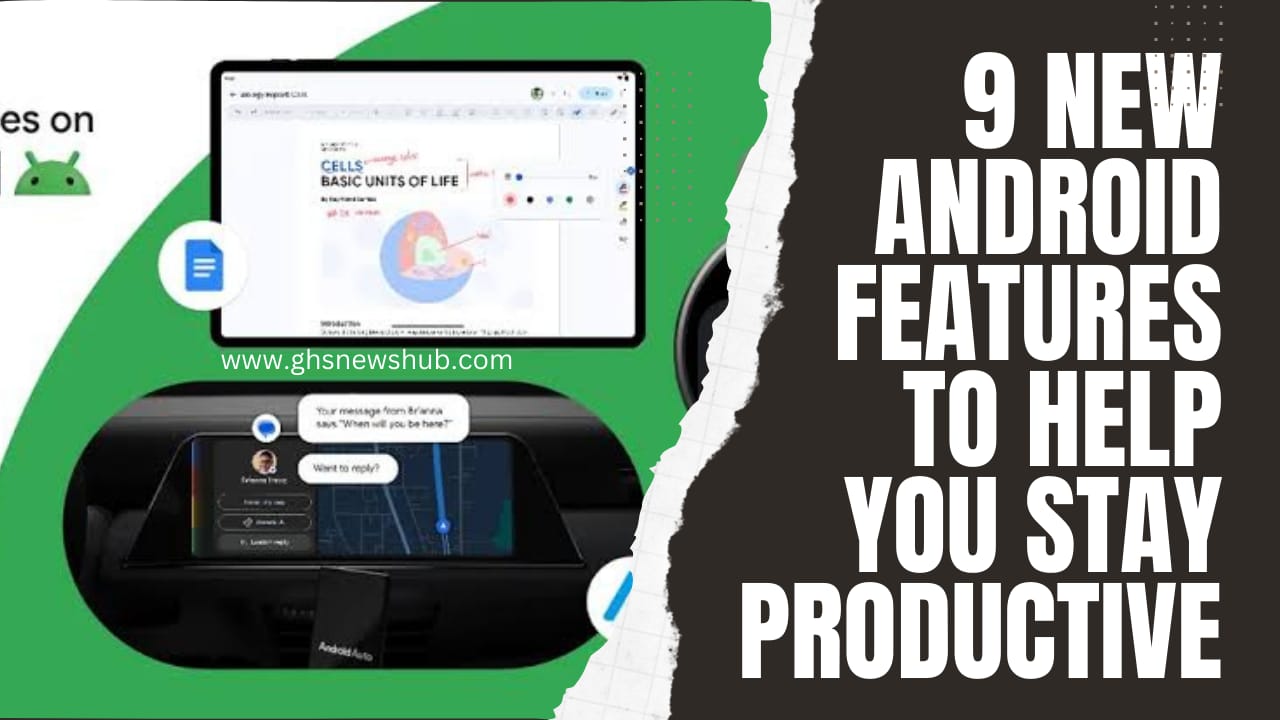Android’s Latest AI Upgrades
Meta Description
Android Features and the latest updates to boost your productivity whether you’re commuting, exploring new places, working remotely, or managing your health & fitness.
9 New Android Features To Help You Stay Productive
Powerful AI integrations allow you to multitask more safely, discover localized details hands-free, streamline documentation, access essential items effortlessly, and view all your health metrics in one dashboard. Let’s take you to the latest Android feature to help you along your daily life routine.
1. Stay Connected On the Road With AI-Assisted
Distracted driving is an ongoing issue as mobile devices keep us connected even in the car. However, Android Auto’s newest AI integration allows drivers to stay in touch safely. After analyzing incoming messages and conversations in apps like SMS, WhatsApp, Messenger, etc., it automatically generates summaries of the key details.
This means you can grasp the core topic or question without taking your eyes off the road. Android Auto also suggests relevant one-tap quick replies like “On my way” or “Can’t talk now” as well as actions to share your live location or start a call. This smart voice-controlled system keeps communication streamlined so you can focus on arriving safely.
2. Blind And Visually Impaired
Android’s Lookout app already empowers people with visual impairments to navigate their surroundings independently through audio cues. Now, the application’s latest upgrade – Lookout’s image captions – generates detailed AI-powered descriptions of photos, graphics, and other visual media.
By leveraging text and object recognition, Lookout can speak out details on what the images contain to provide blind users with crucial context. Designed specifically to increase accessibility for millions globally, this feature is currently available in English.
3. Discover Places in Your Vicinity
Finding exciting new restaurants, stores, landmarks, and other places nearby often still requires pulling out your phone. But Android’s enhanced integration between Maps and Lens allows hands-free area discovery tailored for blind or low-vision users.
By using your phone’s camera with the Lens tool in Maps, screen readers like TalkBack can speak names, addresses, directions, customer ratings, and operating hours aloud. Whether looking for ATMs, retail shops, transit stations, parks, or popular attractions, this sensory-friendly upgrade makes exploration more convenient.
4. Handwritten Annotations Streamline Google Docs Collaboration
While working with distributed teams, providing feedback on shared documents is crucial. But constantly switching between typing comments, using shortcuts, and enabling tracking wasn’t always seamless. To facilitate seamless remote collaboration, the latest Google Docs upgrade finally enables handwritten markups.
Whether using a tablet, convertible touchscreen laptop, or stylus-equipped smartphone, contributors can now add annotations with their handwriting. This not only feels more intuitive but conveys concepts visually through colors, arrows, underlines, and highlights. Streamline your workflows by giving teammates thoughtful edits or approvals right within Docs using virtual pens and highlighters.
5. Media Streaming With Spotify On All Devices
Previously, Android’s default media output switcher in the notification shade was designed mainly for YouTube Music. It provided users with a central dashboard to manually reroute audio feeds between wireless headphones, speakers, smartphones, TVs, and other devices. Now this crossover streaming functionality applies to Spotify too.
Through Spotify Connect integration, the switcher detects all available devices for seamless playback transfer. Whether starting a new playlist on your phone before transferring to living room speakers or having Spotify running in the background during your workout, you stay fully immersed in the music. This upgrade also allows passenger DJ sessions in the car as riders connect to the infotainment system.
6. View All Health Metrics in One Place with Fitbit
Maintaining your overall physical health requires monitoring numerous factors – physical activity, step count, nutrition, sleep cycles, etc. But toggling between various applications and wearables to access this data isn’t efficient. Fortunately, Google’s Health Connect platform and the redesigned Fitbit app centralize your key wellness metrics in one intuitive dashboard.
Sync data effortlessly from leading health and fitness apps like MyFitnessPal, Calm, Oura Ring, WeightWatchers, and AllTrails alongside your Fitbit stats. Tabs on the Fitbit mobile app display your activity summaries, heart rate, sleep score, step count goals, and more in detail with simple visualizations. You get a more holistic view of your overall well-being without repetitive manual data inputs.
7. Wear OS Smartwatches, Digital Identity Cards
Having tickets, boarding passes, loyalty program memberships, vaccine passports, and other digital verification accessible instantly is invaluable when you’re on the move. But repeatedly fishing out your phone can be tiresome. Fortunately, Google Wallet’s core capabilities now extend to Wear OS smartwatches for speedy account access.
Rather than just displaying notifications, these wrist-worn mini-displays let you pull up barcodes, QR codes, and details for seamless check-ins. Keep e-tickets, flight passes, public transit cards, and gym memberships on your wristwatch’s dashboard for tap-and-go convenience wherever you go.
8. Public Transit Navigation Simplified on Google Maps
Commuting without having your smartphone constantly in hand is difficult, especially when relying on maps to route you. But the latest upgrade to Google Maps for Wear OS enables completely phone-free navigation using just your smartwatch. After syncing transit route details from your phone, step-by-step directions are accessible right on your wrist.
Check upcoming departure times, connect to your transit operator’s live feeds, receive vibrational notifications for your stop, and have arrow-based guidance with distance estimations routed directly to your destination. For globetrotters regularly hoofing between hotels, convention centers, airports, downtown plazas, etc., having directions always a glance away keeps transportation efficient.
9. Chat In Google Messages with Gemini
While chatbots for customer service exist widely, few provide helpful daily conversations capable of two-way dialogue. But Google is currently beta testing a unique AI chatbot named “Gemini” directly built into Google Messages for enriched messaging. Rather than just sending links or keyword-triggered responses, Gemini can exchange contextual replies all from within your messaging window.
Have spontaneous conversations, develop ideas collaboratively, get suggestions on places to visit or meals to cook, and more based on your personal preferences and local data. Google Gemini aims to converse naturally while assisting with recommendations to streamline planning events, solving problems, simplifying research, and helping decision-making through friendly chats.
Early user response to Gemini has been overwhelmingly positive as its capabilities far exceed conventional chatbots. While still improving accuracy through machine learning during the trial period, the implications for productivity, accessibility, and convenience are promising.




